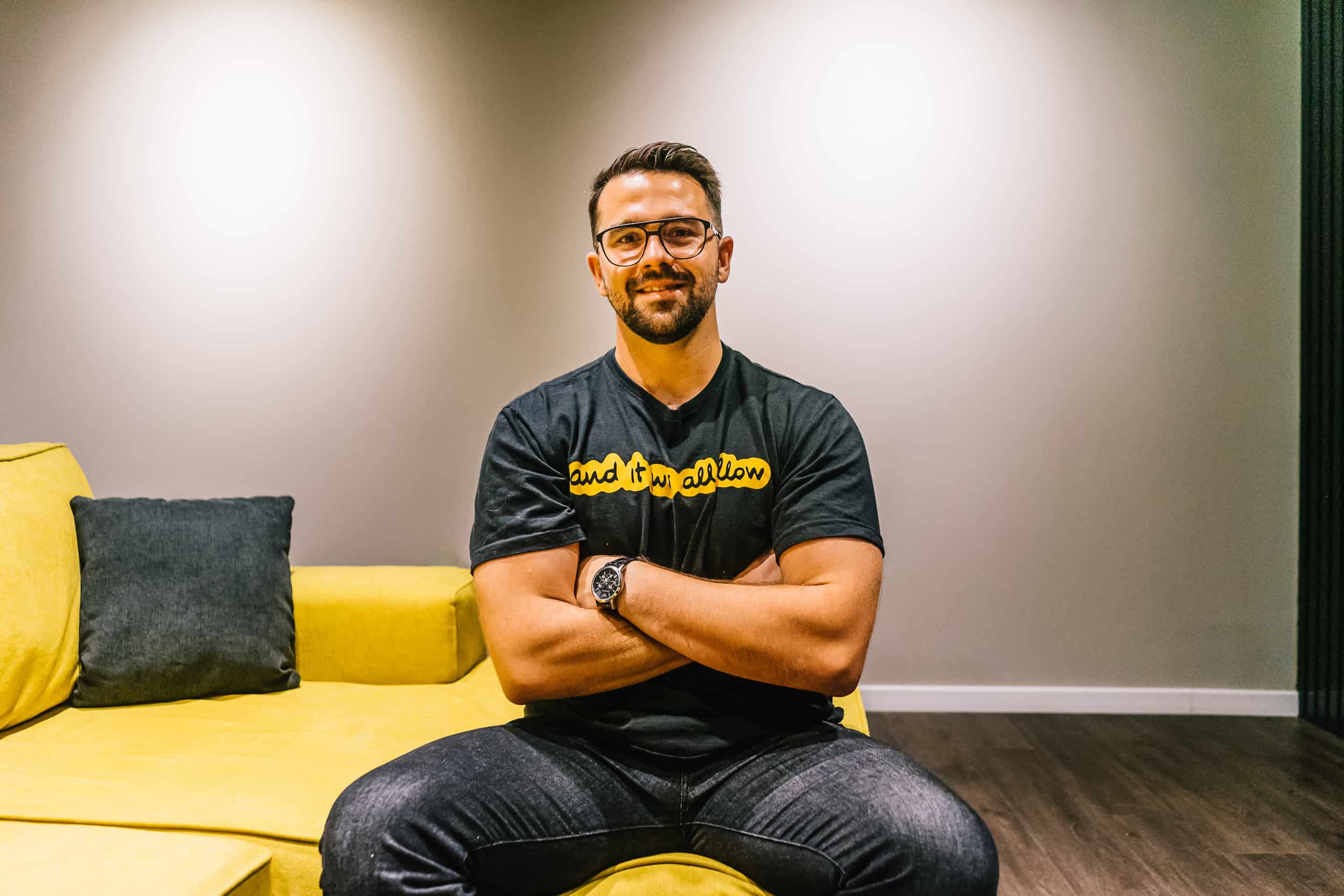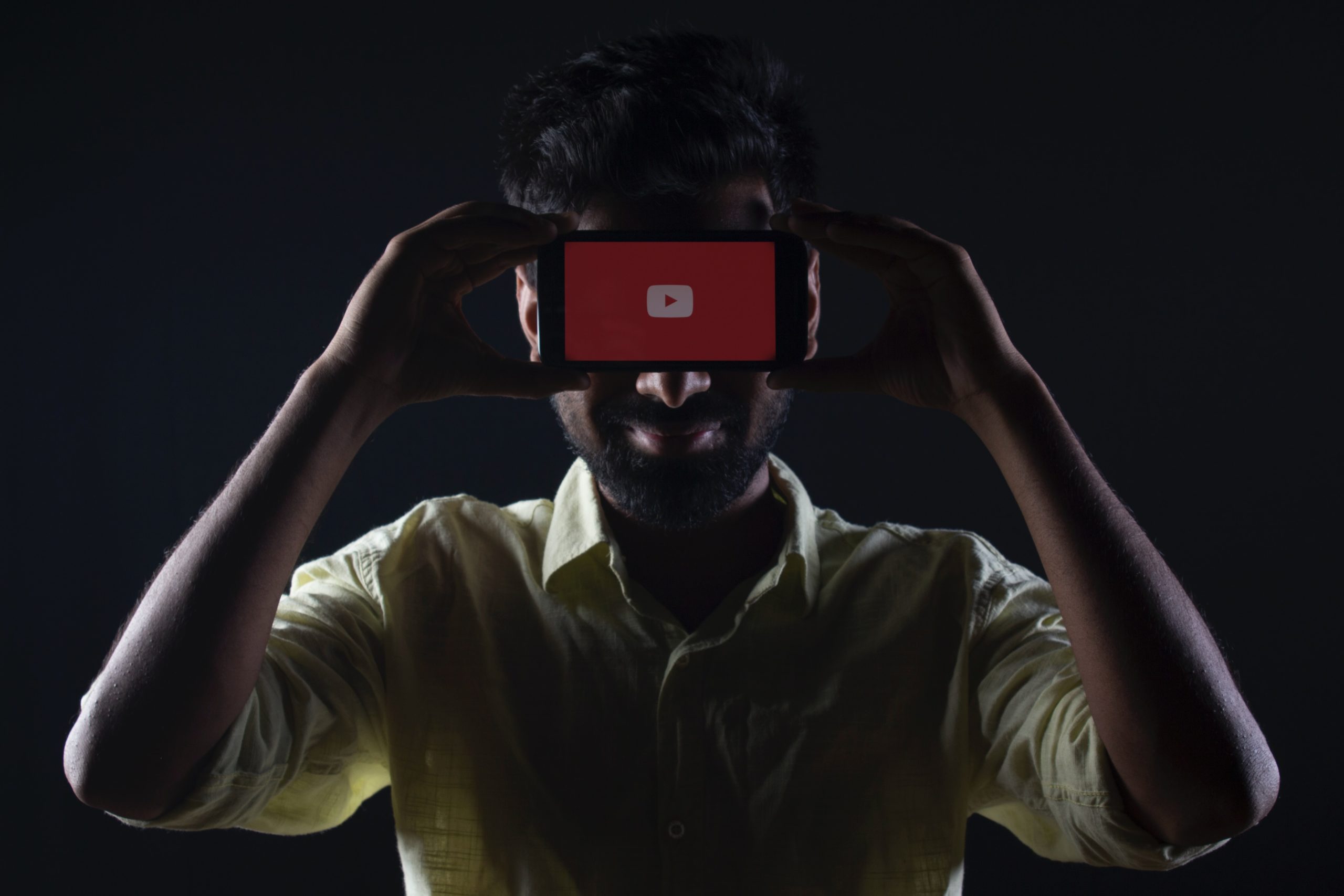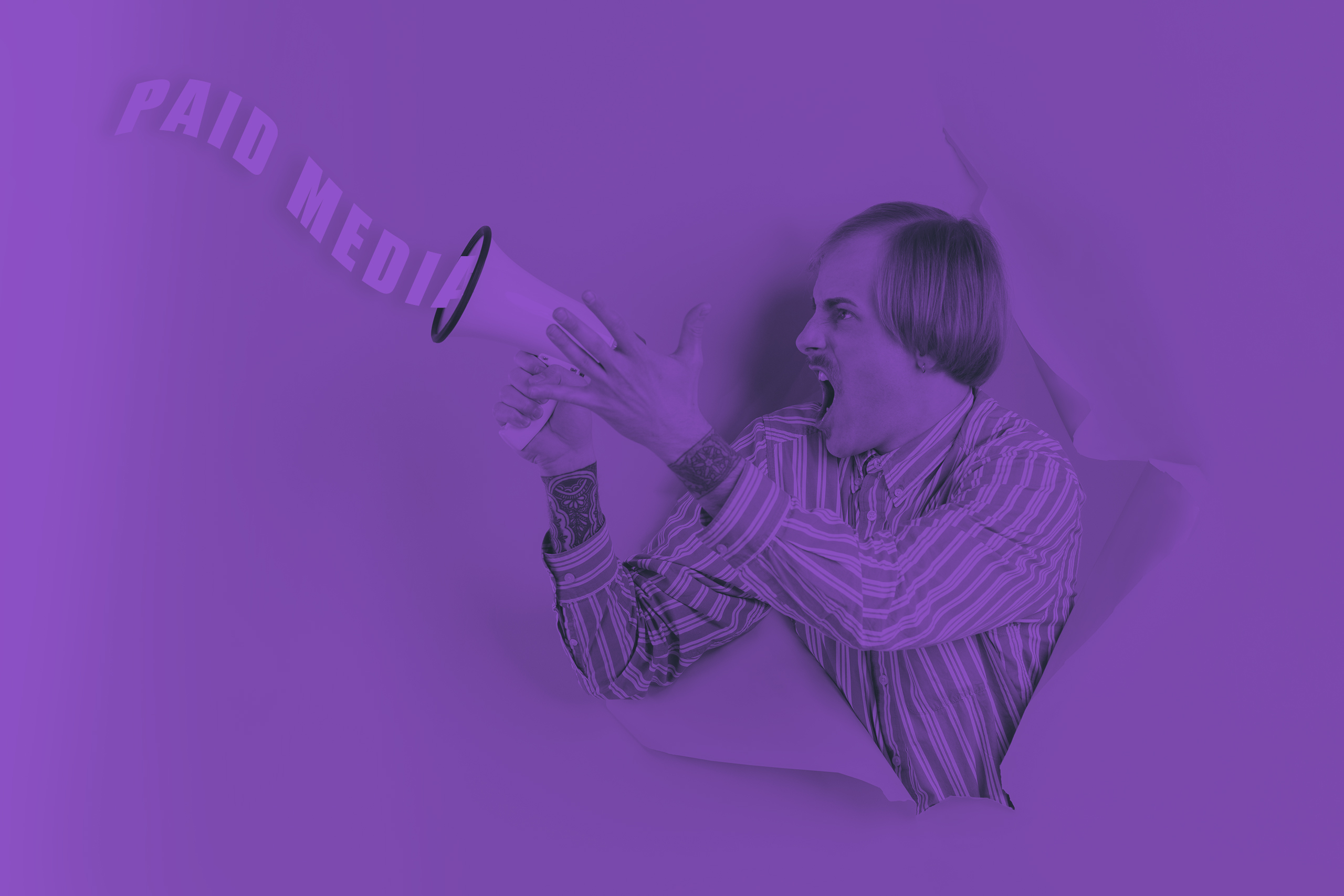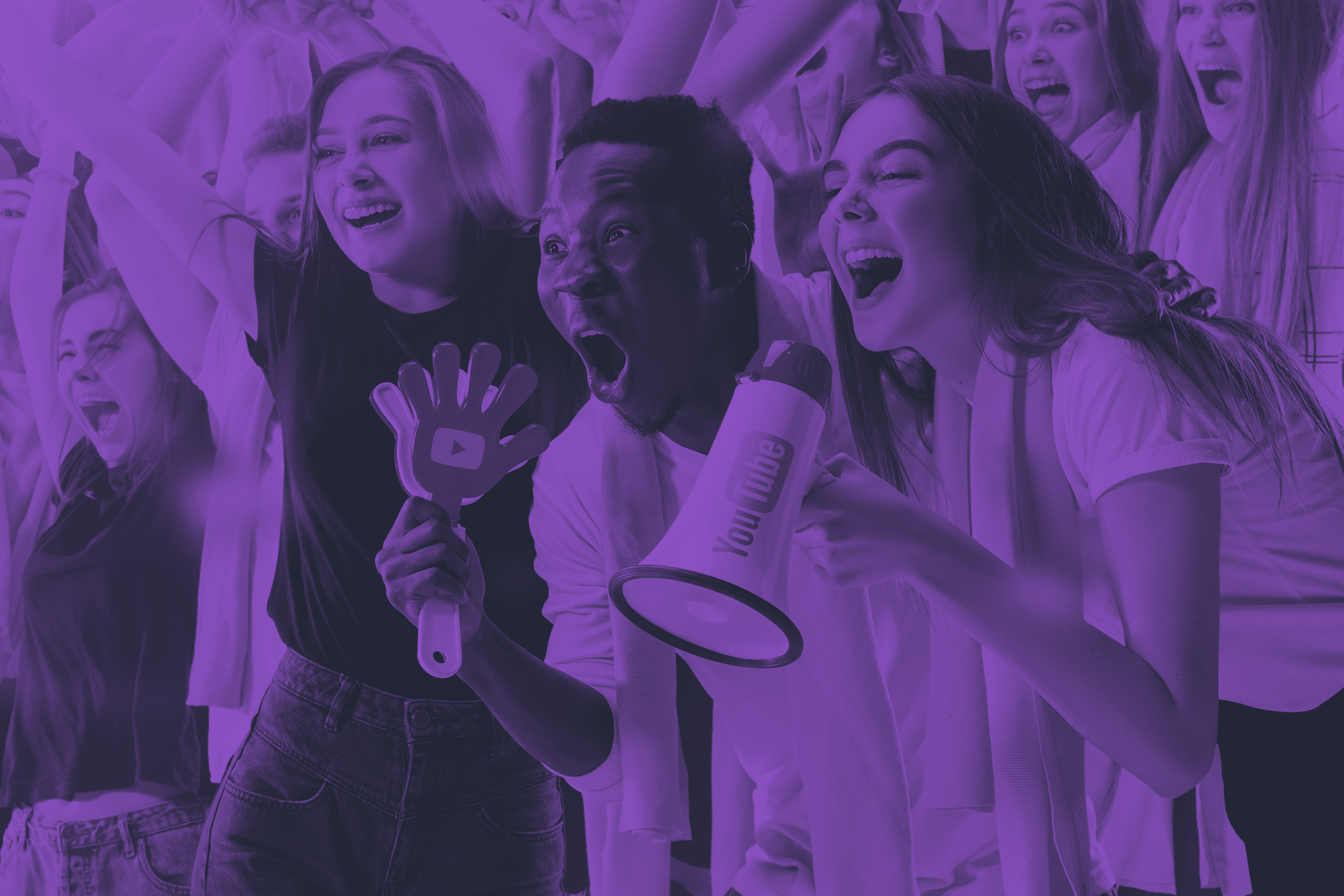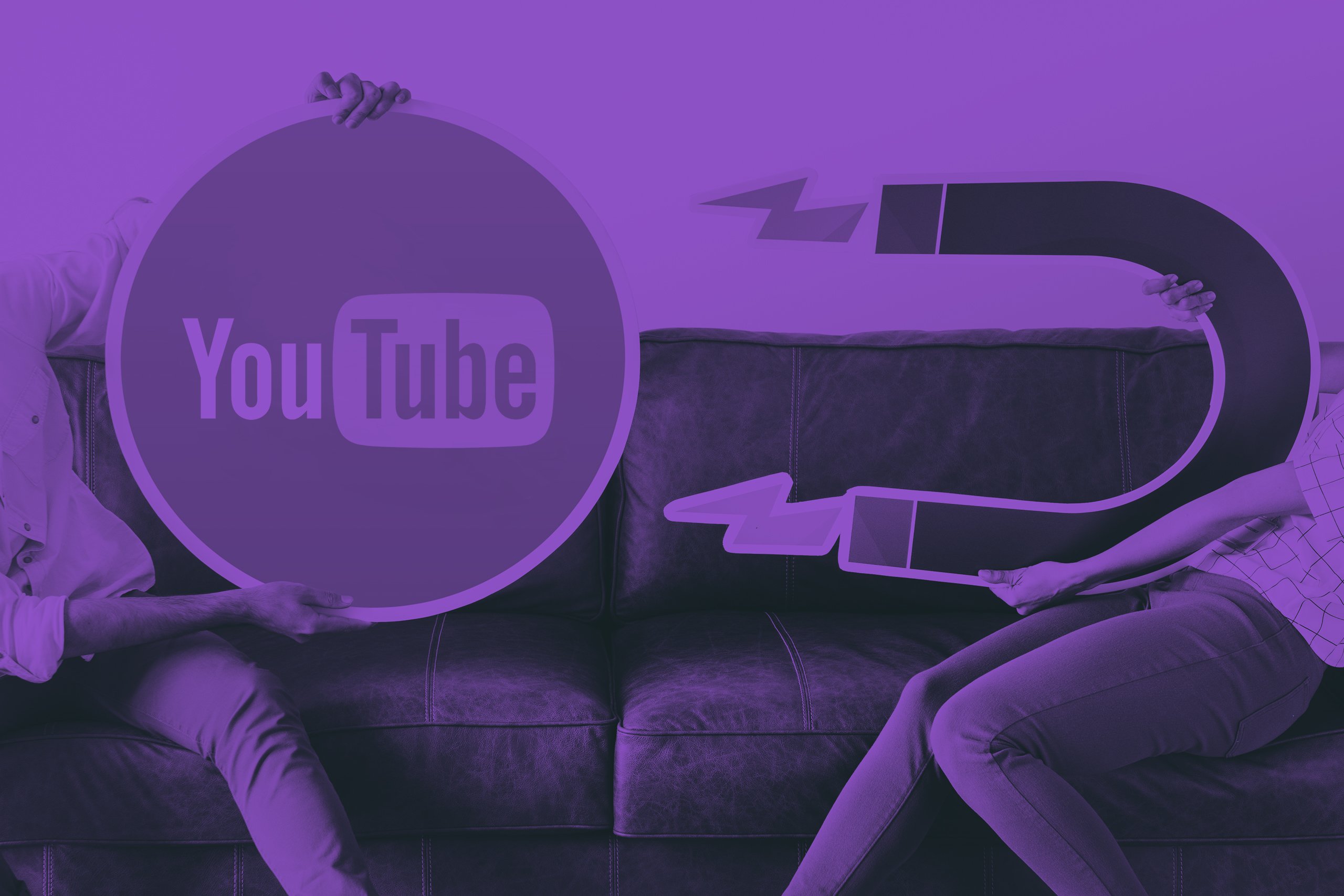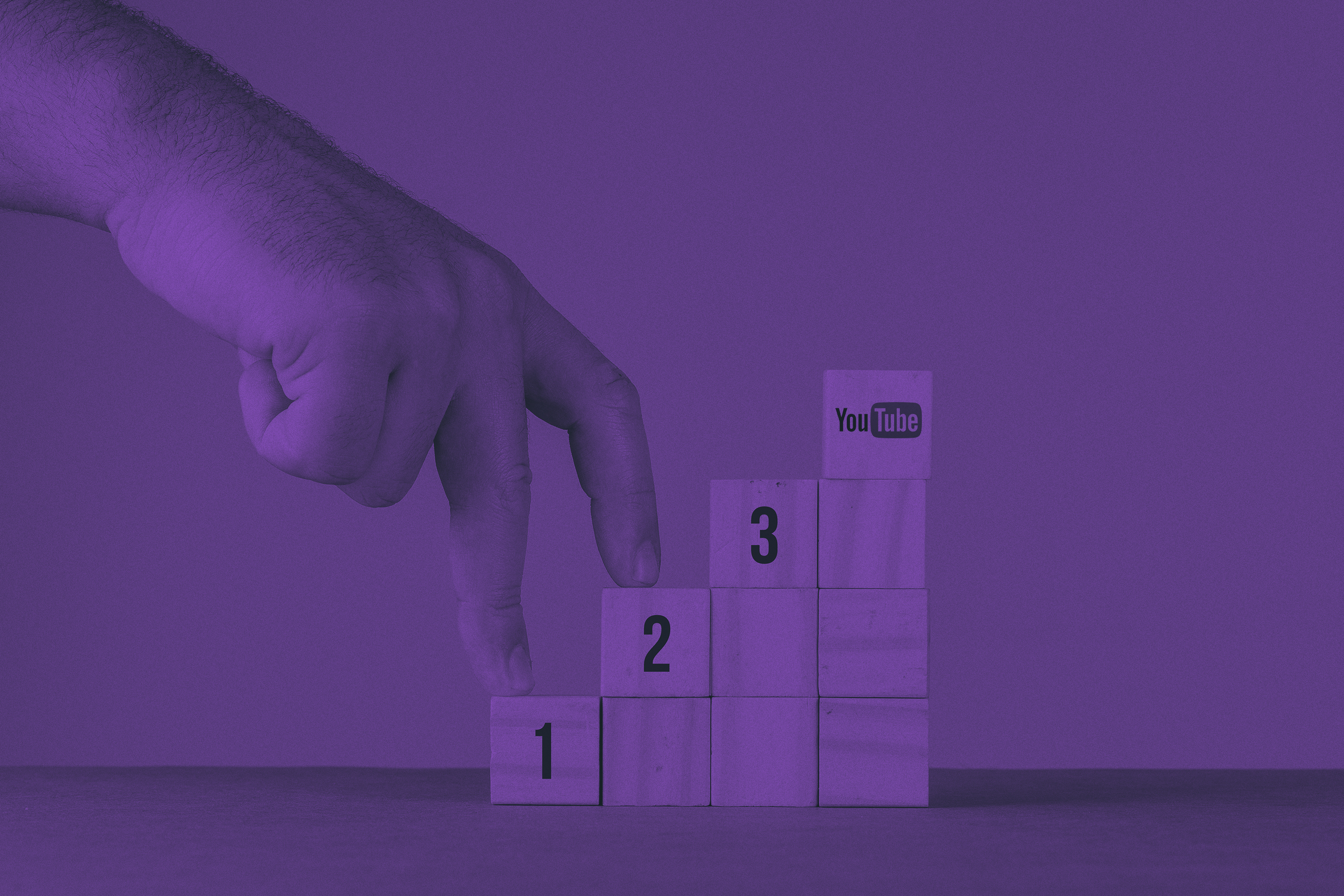Google Ads and the PPC-driven lead gen problems for businesses pretty much go hand in hand.
Google Ads experienced a churn rate of over 45% in the last 12 months. I wonder why?
If only it was as easy as turning on a tap and getting leads?
In this article, I will go over why I believe Google Ads are not working for b2b businesses at scale and some of the primary Google Ads problems, and potentially how to fix them.
Hi, my name is Jason Pittock I am the CEO and Founder of Yugo Media, we accelerate b2b and b2c businesses by harnessing the power of YouTube Ads.
Google Ads vs traditional lead generation
Traditional lead generation is the age-old method for feeding sales with marketing qualified leads (mqls) for the hungry sales team to turn into potential revenue opportunities.
Lead generation for b2c often started with a sketchy advert in the local gazette, newspaper or even a mailout to thousands of people who eagerly cut out the sleazy offer and proceeded to put it on the kitchen fridge.
Yes, along with all the other sleazy adverts… and yeah, they all promised 99% off and life-long-cures to inexplicable problems.
That's marketing, right?
Whereas the case of lead generation for b2b consisted of simply churning out hundreds of cold calls per day, getting past the “gatekeeper” and sending letters in the post to Postal Codes that probably never existed.
Also don’t forget that sales reps would travel thousands of miles, knock on hundreds of doors, and get tonnes of facial rejections with the sole purpose of just a meet and greet of the potential buyer’s secretary with the hope of settling a meeting. With the buyer.
Yes, the buyer is what matters here. The difference was the authenticity and approach to the customer.
So why did this work?
Well as Ogilvy would say “The customer is not a moron, she’s your wife” (source)
In other words, this worked because there were uncluttered, authentic, undistracted, clean metrics to measure marketing efforts, at scale.
But the real reason, why traditional lead generation actually worked was because there was a linear way of measuring key performance indicators that showed progress in the funnel, progressively from leads to sales.
I am not saying we don’t have the measurement of effort vs impact now, but “Houston we do have a problem” with Google Ads lead generation.
Here at Yugo Media, we are honest enough to cut through the noise and talk about what we feel could be a solution to this issue.
Why are my Google Ads not performing in my business?
A question asked by many a CMO, entrepreneur or solopreneur.
Over the past 3 years, Google Ads has become increasingly complex to operate with multiple grades of separation between the “user” and the technology. But more than the technological complexities with Google Ads we have a bigger problem that includes the buyer journey and trust.
Before going any further, let me mention, that when I refer to Google Ads I am referring specifically to
- Display Ads
- Search Ads
Let's talk about the issue of trust. Like any relationship, trust is the underlying success factor of any engagement that's worth the effort of investing in. The same goes for Google Ads.
Over the past 5 years, the average CTR of b2b Google Ads has plummeted.
The current average CTR for Google Search is less than 3% y and Google Display is less than 0,5%.
I wonder why?
The core reason why Google Ads are not performing for their b2b customers is that the customer journey from brand awareness to conversion takes more than a 5-line Ad and a landing page.
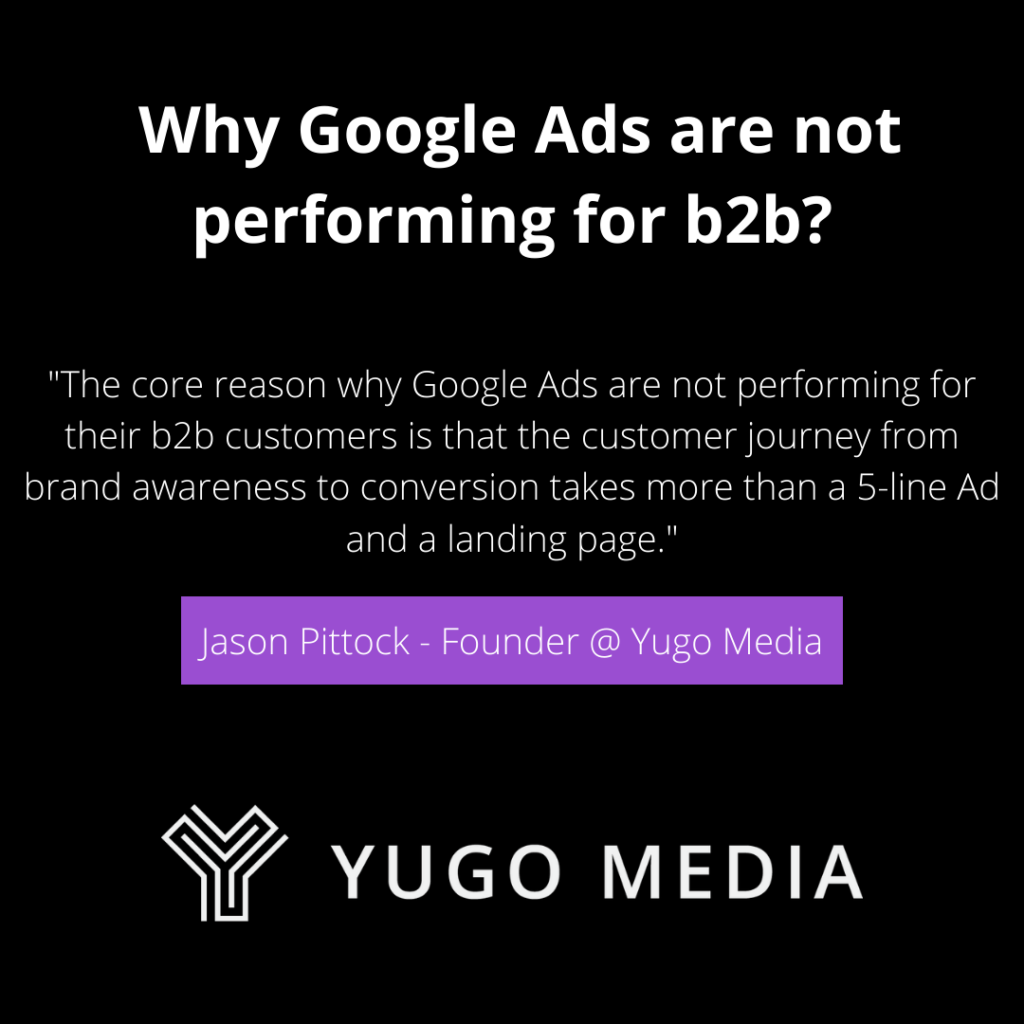
You just can’t spin up a page, create some ads, throw $1,000 into Google Ads and hope it will work.
Or worse still, invest 7 figures and see what sticks.
Our data here at Yugo Media shows that seasoned b2b buyers won’t click on Ads to find their next best supplier.
So how are Google Ads failing their customers?
Well, first of all, let's take a look at why businesses use Google Ads as their go-to platform for lead generation in the first place and then let's look at the expectation vs reality:
- Google Ad users think it's relatively easy to get set up.
- Google Ad users think it's easy to scale the lead generation: plugin and play.
- Google Ad users can get Ads up and running in a matter of hours and compete with the “big boys”.
- Google Ad users can “simply” reach out to any region or market by simply targeting a keyword, or location and creating an Ad.
This does not equal a success story, quite the opposite.
Let us take a look at what generally happens:
| Expectation | Reality |
| Google Ad users think it's relatively easy to get set up. | They end up setting smart campaigns and getting stuck when trying to switch from standard to smart view. Their Ads end up targeting a group of people that may even have nothing to do with their business or business services/offerings, with ridiculous Ad copy extracted from their website by Google’s “Smart” algorithm, (I think this deserves a LOL) |
| Google Ad users think it's easy to scale the lead generation: plugin and play. | You can plug, but you don’t exactly play. Google Ads is designed to either go 2 ways: 1. Use smart campaigns and let Google handle bidding, Ad copy and targeting (Danger) 2. Build a well-structured account that will potentially drive results for your business to sustainably grow lead generation with Google Ads. The problem here is most businesses do not have the resources or time to invest in using Google Ads to maximum potential. Wrong expectations of what Google Ads can and can’t do. |
| Google Ad users can get Ads up and running in a matter of hours and compete with the “big boys”. | This is “theoretically true” but what's missing here, is that to play with the Big Boys, you need to have ample Google Ads experience, and resources to play their game of High CPC, competitive ad strategies and most importantly enough data on your buyer journey to use Google Ads instrumentally to convert cold audiences into conversions. This takes time. You can’t buy your way to the top. You have to take the stairs. |
| Google Ad users can “simply” reach out to any region or market by simply targeting a keyword, or location and creating an Ad. | This isn’t always such? Want to know why? 50% of search traffic on Google is bots, and if you use a VPN you can easily click on an Ad targeting California, while in Greece. (I tried it, believe me) Geo-targeting on Google Ads with search and display has always been an issue, unfortunately, Google will prioritize its revenue therefore targeting has often in practice been loose and very badly managed within their algorithm. Keyword targeting is great, but what user intent are you focusing on? Which stage of the buyer journey are you focusing on? These questions often don’t come up until the budget is fully spent and no results are actually shown. Doing correct keyword research from the buyer persona perspective early on is key to showing the right ads to the right person, at the right time. |
What are the 3 biggest problems with Google Ads as a platform?
Google Ads evidently has issues with how the advertising and business community perceive its value. Here are the ultimate 3 ways Google Ads are failing b2b lead generation efforts and the marketing community:
Not managing expectations with single-channel advertising
Sadly the biggest advertiser in the world (Google, Aka Alphabet) spends more than 2.5 Billion on advertising (link) convincing entrepreneurs that their Ads drive immediate business growth, increased demand and more customer loyalty. Advertising on their platform supposedly will take your business from the back row to the front row, in a matter of minutes.
This is setting wrong expectations.
Singlehandedly, Google will not fix a demand generation problem, it also won’t increase customer loyalty and the lack of product-market fit.
Google Ads is a single-channel platform and should be used as part of an integrated marketing strategy.
VC Backed startups, spend 40% of their budgets on Google Advertising, and Facebook (link)
Throwing marketing budget at a platform to just simply expect an ROI without really analyzing if:
- The ICP is actively buying your products/services by simply clicking on an Ad and magically converting it into revenue.
- Showing credibility and product/service maturity
- Having a clear product-market fit
Is practically like flushing your hard-earned marketing budget down the drain.
Moving slower into Google Ads with better foundations, realistic expectations and high appreciation of the buyers' journey will likely save handsomely on budget and time.
Data is good, but showing the right data is better
Google Ads unfortunately shows a lot of data if you want.
It's a bit like turning on the tap of a high-pressure fire hydrant and trying to water plants.
It just isn’t going to work.
Instead of focusing on so many data sets, ideally, users should focus on two or max three key metrics that are going to directly have an impact on their ROAS (return on ad spend)
The 2 to 3 metrics I would focus on are
- Cost per lead (CPL)
- Page conversion rate (traffic/conversions) (POS)
- Acquisition cost
Google Ads with their purpose of showing their users more data to make better decisions, actually end up doing the contrary causing analysis-paralysis. So much data, but not enough executive actions.
Find a metric you can improve on, and stick with it. Being all over the show is only going to slow down your optimization process and scalability.
Failing to interpret buyer journies and customer acquisition costs
A buyer's journey can sometimes look like a game of snakes and ladders.
Expecting a single advertising channel to fix that to a straight line is not realistic, Google Ads can service your marketing strategy but it can’t be the only strategy.
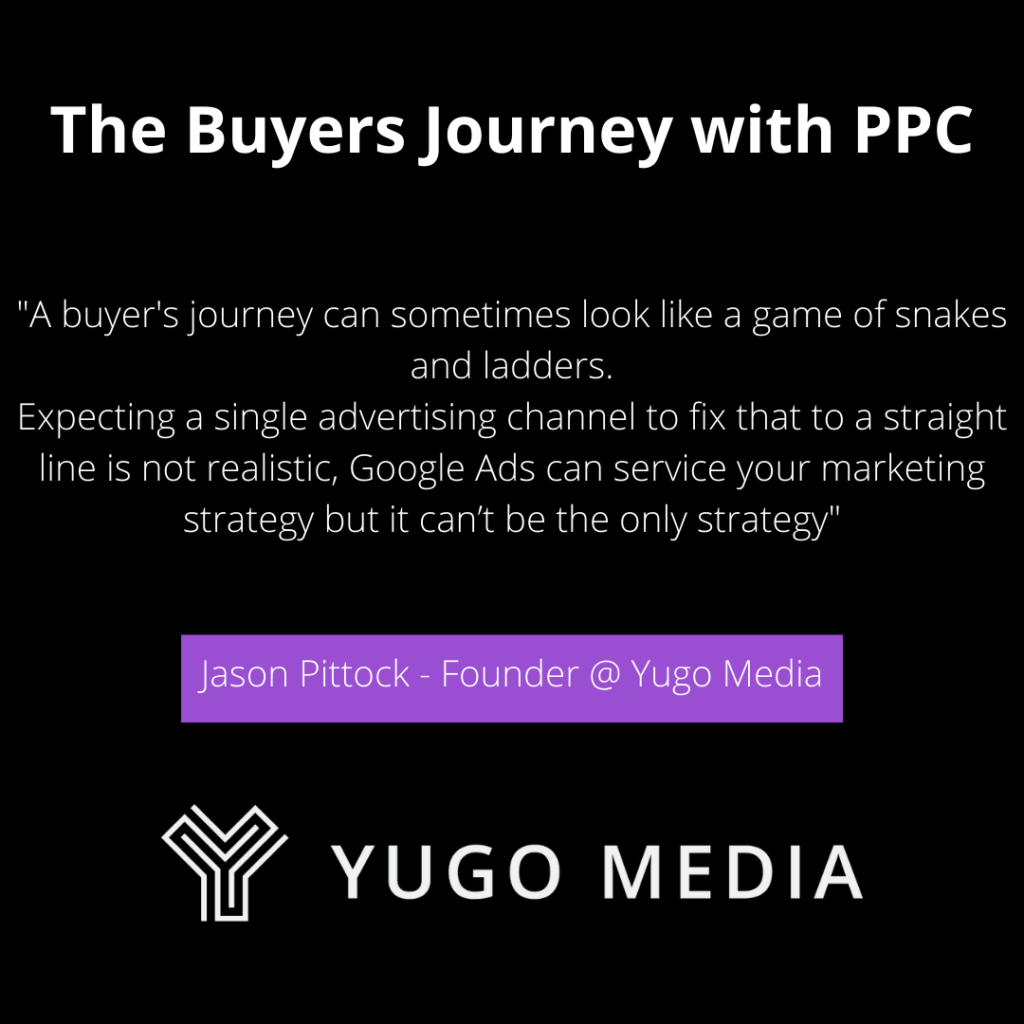
Most importantly, businesses can fail to realize that Google Ads is a component of a strategy stack that is your marketing plan or go-to-market. Google Ads can serve well at a given stage of your buyer journey, but they most likely could be a stage that it doesn’t.
For example, let's imagine you are selling an info-product, or you are a business coach using Google Ads for lead generation.
If you collect leads with a lead magnet (for example a free course, giveaway, webinar etc), and then use your sales team to reach out to each lead and nurture the lead towards conversion. This potentially may be more efficient than using retargeting or display. If your acquisition cost is below 50% of your revenue, you have the budget to invest in the sales staff and the nurture stage.
On the contrary, if you are a b2b saas, and you use Google Ads for lead gen, potentially your LTV is lower, and your acquisition cost more than 50%, you are better off using a different lead gen method and leveraging Google Ads on bringing your warmed up leads back into your funnel via retargeting with display or video.
What's important, is that you focus on where your customer is a what stage, how much can you invest into conversion and using Google Ads instrumentally to facilitate the journey towards a conversion.
How to successfully use Google Ads as a B2B
If you are a b2b business and want to successfully run Google Ads to get sustainable results that can scale with a positive ROI, consider the following list:
- Expect tangible results 60-90 days from when you start, it isn’t “plug and play”
- Don’t be fooled by the “simplicity of the platform”, find someone who specializes in Google Ads, or train yourself with the knowledge and finesse needed to navigate Google Ads efficiently
- If you have a low-ticket value product, do not use Google Ads or YouTube Ads. We recommend that any revenue opportunity below $500 dollars is not sustainable to break even. (Sorry to be blunt, we just want to save people the time, effort and frustration of going do a costly rabbit hole)
- Focus on inserting Google Ads into your strategy and not creating a strategy around Google Ads
- Consider video Ads that create more authority and trust (see what are the alternatives to Google Ads)
- Focus on building trust with your campaigns, this will pay off in the long run way better than burning throw a budget that's just focused on converting sales that will only fix your short term needs
- Use forensic optimization: collect as much post-click data as you can, and use this to make decisions about your landing page design, campaign strategy, placements, keywords, etc.
- Use automation and custom scripts to accelerate performance with bidding, exclusions, keywords, placements, ad copy, etc.
- Understanding attribution modelling and final customer acquisition attribution
- Structure your Account for easy management this will help with scalability and performance
- Use a performance log or change log to document all changes that could impact performance. (quick tip, you can use Google Analytics annotation tool)
What are the alternatives to Google Ads?
Here at Yugo Media, we focus on YouTube Ads, we do manage traditional Google Ads (search, shopping and display) but we are moving as many of our entrusted customers towards YouTube Ads.
What's the deal?
Well simply put, trust is becoming the most important element of paid advertising.
YouTube Ads provides powerful audience management, granular targeting and laser-focused engagement strategies. These combined have outperformed traditional static Ads by more than 4x.
Are YouTube Ads the future?
I don’t know, I am not a “guru - know-it-all” but I do believe that the flourishing future of Paid Media will highly depend on the power of video.
Currently, from our experience, video is the most authentic way to create trust and engagement between brand and buyer.
If done right, YouTube Ads will solidify brands, unite marketing strategies and sales funnels, and most importantly it allows creators to show value only to people who truly need it.
Why should b2b and b2c businesses consider YouTube Ads over other advertising platforms?
This is never a good question to ask me, as I live and breathe YouTube Ads nowadays. So this could be very long-winded and monotonous, so by the time I give you the juicy part you have either gone to sleep or stopped reading, so here goes:
- YouTube Ads give granular control over keyword targeting. Different to Facebook or TikTok that has “interests”
- YouTube Ads share data with their big brother Google. So any search footprint or pattern in Google can trigger certain activities on YouTube.
- YouTube has shown to have a lower amount of bot activity or compromised profiles. This is a huge benefit to reducing click fraud and fake click activity that produces false positives.
- YouTube Ads provide us with the opportunity to create an impact in an extraordinarily small space of time. This will ensure improved customer retention and conversion rates.
- YouTube is a platform that is still considered “new”, the lack of saturation allows advertisers to stand out and make an impact.
How to make the transition from Google Ads to YouTube Ads?
Transitioning from Google Ads to YouTube Ads is not as hard as it may seem. But there are a few important steps to take into consideration when making the transition.
Before getting started, analyze who will be the face of your YouTube Advertising campaigns, we recommend that you choose somebody in your business or organization who is comfortable behind the camera and has some public speaking skills.
At Yugo Media we help our customers with video strategy, building great video scripts, recording and post-production.
Once you feel comfortable with your video partner and advertising strategy take a look at your current Google Ads structure. Most importantly if you have current campaigns that are structured into different stages of your buyer journey it will be easier to transition them to YouTube Ads:
- Lead generation campaigns: free mini-courses, ebooks, giveaways.
- Lead magnets and nurturing campaigns: webinars, webinar replays, podcasts etc
- Action-focused campaigns: scheduling a call, setting an appointment, filling out an application
- Nurturing and retention campaigns: bring people into the funnel that are either in a decision stage or have already converted and considering an upsell or retention.
FAQS related to YouTube Ads Lead Generation
How do you collect leads from YouTube Ads?
Businesses can collect leads with YouTube Ads by using opt-in lead magnets on their landing pages to collect lead details such as email and name.
How do you get set up in YouTube Ads?
YouTube Ads is located within Google Ads, making it easy and straightforward to get set up if you have a current Google Ads account. To get set up with YouTube Ads, you build a campaign strategy, create an ad group, select the YouTube video you want to use (preferentially be unlisted) and create the Ad. Remember to choose a bidding strategy, budget and targeting options when creating your campaigns.
How good are YouTube Ads for lead generation?
YouTube Ads have been shown to perform exceptionally well for info-products, e-commerce and b2b lead generation for niche businesses. The reason why is related to the impact created by a single touchpoint with video. Video allows to communicate trust and authority in a very small window of time, this also allows to pre-qualify the leads and drive engaged traffic into a funnel.
What is average ROAS with YouTube Ads?
The average ROAS with YouTube Ads is between 200-350% depending on how many touch points you have within your buyer journey.
What's the average Cost Per Lead (CPL) with YouTube Ads?
The average cost per lead (CPL) is between $5 and $10 dollars.
How do you successfully run a lead generation campaign on YouTube?
The 2 biggest recommendations would be: make sure you are comfortable with video and you have a product-market-fit that has a high ticket value.

